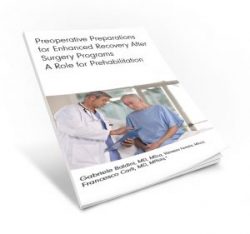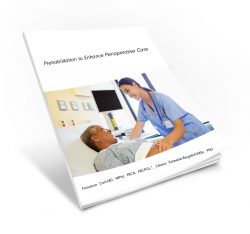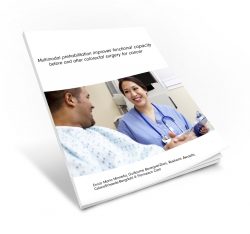What the practitioner should know
Prehabilitaton can be defined as a process that occurs between the time of diagnosis and the beginning of acute treatment and includes physical metabolic and psychological assessments that establish a baseline functional level, identify impairments, and provide interventions that promote physical and psychological health to reduce the incidence and/or severity of future impairments”. It is important to highlight that this definition addresses the concept of multimodality as it states that physical and psychological parameters must be both assessed and included as elements of an intervention.
Also, the physiological conditions of the patient must be optimized in order to maximize the effects of the intervention. For instance, if a patient is malnourished, their response to exercise training may be mitigated by their state of nutritional health
Considering the relatively short widow of opportunity for prehabilitation, it is critical to support the full physical and psychological needs of the patients in order to best prepare them for upcoming surgery and recovery
Over the past decade, prehabilitation has gained recognition as an important means of improving preoperative fitness in order to mitigate the usual decline in physical function detected in the post-surgical period. Not limited to its impact on quality of life and independence, poor functional capacity may also interfere with the patients’ capacity to sustain subsequent cancer treatment.
Even at three months post major elective abdominal surgery, up to 50% of patients demonstrate a protracted disability. The return to functional independence is important for patients, care-givers and the health-care system at large. Prehabilitation, when integrated into a fast track and enhanced recovery framework, may play an important role in surgical care by improving post-operative outcomes through the enhancement of functional recovery in the pre-surgical period
The role of prehabilitation may also extend beyond the perioperative period by means of improving the patient health status prior to receiving subsequent cancer treatment as chemo, radiation and hormonal therapy are all known to have a detrimental impact on functional capacity.
Surgery represents a major metabolic stress which promotes loss of lean muscle mass, homeostatic instability and the impairment of aerobic capacity. Patients who undergo major surgery stay in the hospital, on average, a total of 7-9 days, with the largest number of bed days attributable to the postoperative recovery period. Clearly, a rapid return to full physical function after major surgery has the potential to improve outcomes for patients, thus allowing them to return home and resume normal activities earlier. Furthermore, accelerated early recovery also has health-economic benefits and potentially more efficient use of available hospital beds.
The introduction of fast track and enhanced recovery protocols targeting the intra- and postoperative periods have been shown positive results, but relatively little attention has been placed on optimizing patient physical function in the pre-operative period, yet this offers many advantages as it is not affected by post-operative symptoms and concerns. For most elective procedures there is a waiting period prior to surgery when patients are motivated and available, and this represents as an opportunity to intervene in a targeted fashion to try and improve post-operative recovery. Active engagement of the individual in the preparation process may have benefits beyond the physical, and alleviate some of the emotional distress surrounding the anticipation of surgery and the recovery process.
Firstly, both physical activity and exercise must be clearly defined: physical activity can be understood as any bodily movement produced by skeletal muscles that results in energy expenditure, while exercise is a clear subset of physical activity that is planned, structured, and repetitive and has, as a final or an intermediate objective, the improvement or maintenance of physical fitness. It is important to emphasize that all of these factors are important components of prehabilitaton and, taken together, provide a multifaceted intervention to change lifestyle behaviours, improve physical function and enhance recovery.
Current recommendations for the general population include 150 minutes of moderate or 75 minutes of vigorous physical activity per week, which- unless deemed to be contraindicated by the physician responsible- can be safely performed by the pre-surgical cancer patient in order to obtain substantial health benefits. Exercise prescription should specify frequency (how often?), intensity (how hard?), time (how long?) and type (what kind of exercise has been prescribed?). For exercise prescription purposes, the recommendations are typically based on the guideline of 150 minutes per week and broken down into bouts of aerobic training that should occur at least every second day, for approximately 30-45 minutes in duration, at a moderate level of intensity (for example, 50-75% of age predicated maximal heart rate).
Malnutrition from either inadequate food intake and/or metabolic and inflammatory changes that alter nutrient requirements or absorption leads to wasting and diminished physical function. It is associated with increased morbidity, longer hospital stay and readmissions, prolonged surgical recovery, and poorer quality of life. North American surgical consensus recommendations suggest nutrition therapy in all at risk patients to potentially mitigate any malnutrition-induced complications throughout the perioperative period.
Nutritional care includes sufficient protein to achieve anabolism and sufficient energy to maintain body weight at times of major stress . Account should be taken of the quality of the protein, the density of the protein in the protein food source and the non-protein food source. Non protein components of diet, fat, carbohydrates and fibers as well as micronutrients need to be integrated. The integration of nutrition and physical activity maintains physiological reserve sufficient to mitigate the stress associated with surgery. In order to generate a positive net protein balance in favor of lean body mass accretion, essential amino acids need to be administered to produce a state in which protein synthesis exceeds that of protein breakdown. Twenty-thirty grams of protein taken immediately after resistance exercise in liquid form is regarded as sufficient to maximally stimulate muscle protein synthesis in healthy individuals.
In the context of surgery, psychological distress has been shown to negatively impact wound healing, postoperative pain relief, result in longer hospital stays and more functional limitations. Anxiety and depression is very common in patients with a cancer diagnosis; depression in this population has been shown to be associated with low levels of functional capacity, higher levels of pain, non-compliance with medical treatment, diminished immune response and carries an elevated risk of mortality. High rates of anxiety and depression in the cancer population, as well as the negative effects of psychological distress on mental and physical well being, have led to the study of whether preoperative psychological interventions can effectively reduce psychological distress in this patient population. Evidence supporting the role for ‘psychological prehabilitation’ before surgery comes from RCTs in breast, colon and prostate cancer patients. Interventions implemented prior to surgery, such as relaxation techniques (deep breathing, progressive muscle relaxation and meditation), guided imagery have shown to a positive effect on pain severity, fatigue, quality of life.
It would make sense to target those who need particular attention such as the older, the frail, and those who are at risk for malnutrition.
Older patients tend to have more postoperative complications and a longer convalescence than younger patients. In fact, surgical morbidity and mortality increase with advancing age and rise sharply after the age of 75. Elderly patients tend to spend more time sitting and in bed, with negative impact on muscle mass and cardiovascular homestasis, thus leading to poor preoperative functional and nutritional status. Multimodal prehabilitation is an attractive care strategy for this population as it aims to increase functional capacity during the preoperative period in anticipation of the upcoming stress of surgery and the metabolic cost of recovery.
Frail patients pose a significant challenge to the health providers as this population has many chronic diseases such as cancer, dementia, coronary artery disease, thus requiring multiple interventions. Frailty is associated with functional decline and disability, and it would seem logical that this group could potentially benefit from multimodal prehabilitation. Because of the vulnerability to decompensation, acute stressors such as intensive exercise can precipitate a catabolic event, such as surgery or subsequent treatment. Structured and personalized prehabilitation programs (including moderate exercise protocols, combined with nutritional optimization and adequate psychological support) can impact on postoperative outcome. This rapidly developing area of clinical research is needed in order to provide optimal perioperative care for the frail individuals.
We have here reviewed the concept of surgical prehabilitation and elaborated on interventions to enhance functional capacity and have a maximal impact on postoperative outcome.
It becomes evident that prehabilitation must be integrated comprehensively with other elements of the ERAS program to maximize its effectiveness. A multimodal approach during the preoperative period can include medical and pharmacological optimization, correction of anemia, alcohol and smoking cessation, physical activity, nutritional optimization and anti-anxiety strategies. Such an approach may indeed offer an opportunity to preserve or enhance physiologic integrity and optimize surgical recovery.
Multimodal prehabilitation requires an interdisciplinary approach as it proposes a shift from the current health care paradigm. The challenge is to recognize that the preoperative period represents an opportune time to intervene preventatively and that the key is to capitalize on this period of time in order to promote more effective clinical care.
To facilitate participation by patients that have difficulty physically coming into the clinic and/or that live far away, we are developing tele-prehabilitation whereby the patient is in contact via Zoom with the POP team, receiving exercise training, nutritional counseling and psychological support.
See the real life impact of prehabilitation
This video by the Montreal General Hospital Foundation shows the real life impact of prehabilitation in the life of a patient and three doctors.




